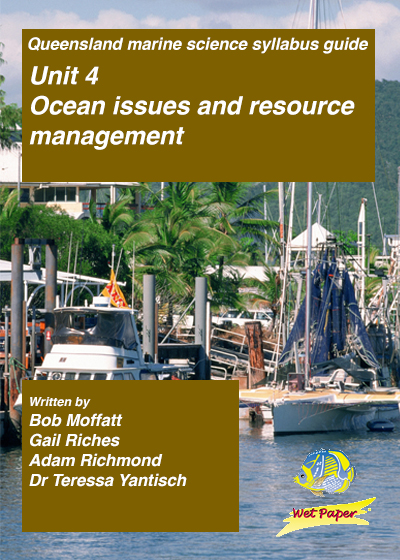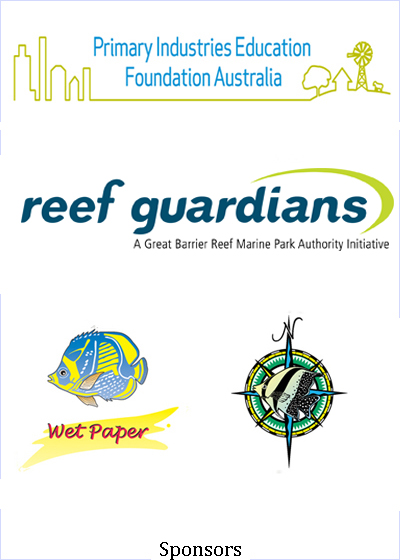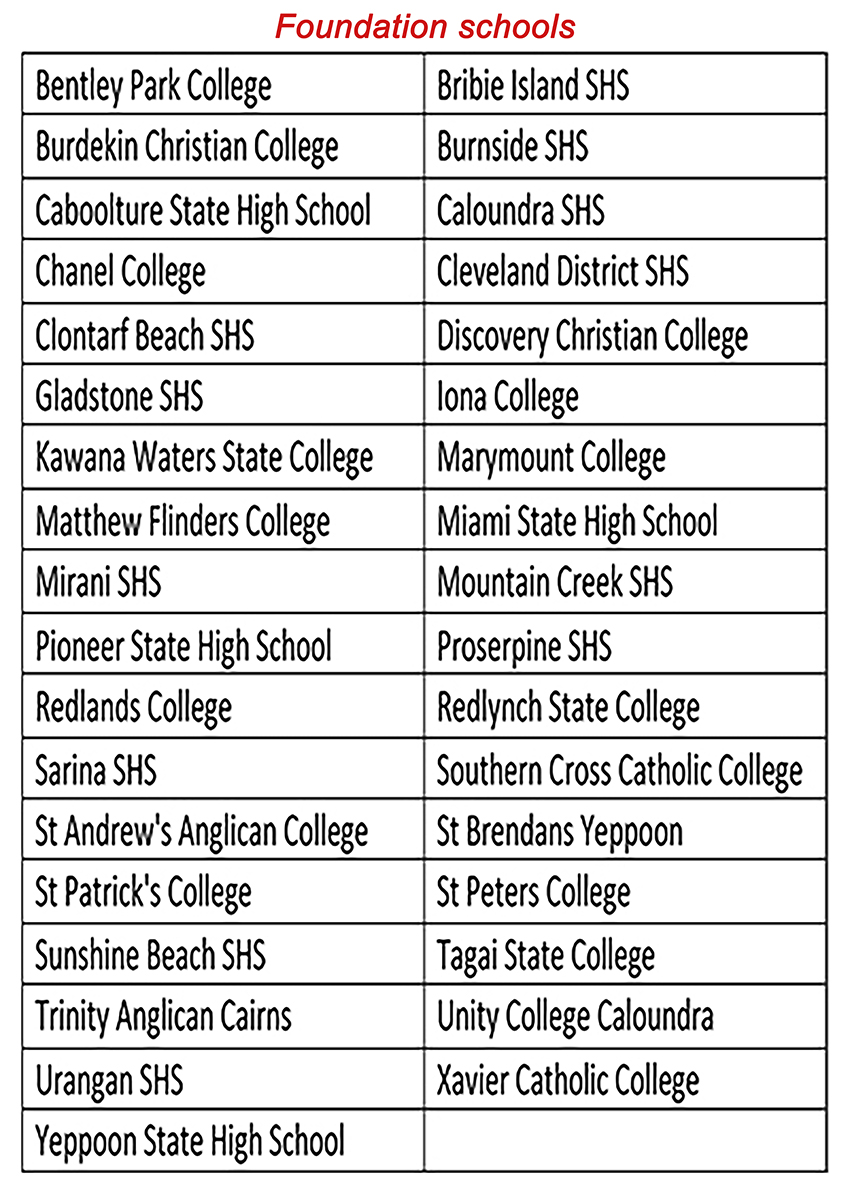UNIT 4 Ocean issues study guide

ISBN : 978-1-86283-174-2
Published Date : 21 October 2021
Product Code : F 51P
Format : FREE downloadable pdf with school licence
by
Bob Moffatt, Gail Riches, Dr Teressa Yantisch and Adam Richmond
Note: File size is 120Mb. Convert to power points with adobe acrobat pro.
Citation
This publication should be cited and acknowledged as:
Queensland Marine Science Syllabus Guide V1.2 Unit 3.1 Marine systems connections and change, written by Adam Richmond, Gail Riches, Dr Teressa Yantsch and Bob Moffatt, Wet Paper Publications 2020
Teachers Information
Self-funding legacy
This Wet Paper legacy project is self-funded from the sales of a small number of books to allow future marine educators to take our original ideas from 2021 and make them relevant in 5, 10 or even 20 years in the future.
Copyright
The Moffatt Group Australia Pty Ltd 2020.
Price
The publication is FREE.
Licence
With the exception of the content supplied by third parties, logos and other materials protected by trademark, the content of this publication is licensed under the Creative Commons By Attribution, NonCommercial, Share Alike Licence. A summary of licence terms is available from the Creative Commons.
Abstract
This unit comprises 38 pdf interpretative guides for Topics 1 and 2 of Unit 4: Ocean issues and resource management, from the Queensland Marine Science V1.2 QCAA syllabus January 2019.
These guides which were produced as part of the Wet Paper legacy project for teacher in service between 2017 - 2021 by project team members Bob Moffatt, Adam Richmond, Dr Teresa Yantisch and Gail Riches in conjunction with 35 Queensland schools, the Primary Industries Education Foundation, Great Barrier Reef Marine Park Authority Reef Guardians Program and the Marine Teachers Association of Queensland.
The guides link to a wide range journal articles, web references, video links, information from marine education publications and draw on a wide range of marine education experience from the project team.
The pdf files are designed for teachers to create their own school power point presentations and are written to satisfy the standards of the Queensland Curriculum and Assessment Authority.
Background, funding and sponsorship
Between the November 2016 – June 2021, Wet Paper created a pdf convert to power point series for the 2019 Queensland Marine Science syllabus using resources from
- financial contributions of 35 schools
- sponsorship from the Great Barrier Reef Marine Park Authority and the Primary Industries Education Foundation Australia and
- support from members of the Marine Teachers Association of Queensland.
These resources were applied to developing 90 power points for Units 3 and 4 of the then, new, un-trialled Queensland Marine Science Syllabus by
- paying three teachers to be timetabled at either 0.2, 0.4 or 0.6, from their respective schools, for times ranging from 3 - 9 months
- organising conference promotions and limited peer review
- contracting editorial and technical production expenses
- renting cloud server space and software programs
In 2018 Bob outlined the project at a presentation at the MTAQ conference entitled
New marine science syllabus resources
In September 2019 the largely un-peer reviewed trial power points were mailed by USB to the 35 schools.
From October 2019 - April 2021 a series of surveys and workshops were conducted using marine teacher volunteers from these 35 schools who provided valuable input into the functionality of the design. The final product is the result of the 5 years’ work from all those individuals and organisations acknowledged below.
Design
Creates manageable sized files that are licensed to share with students from school cloud servers that assist with remote learning situations with the following features
- Syllabus subject matter statement, definitions, syllabus verb/s and explanations
- Syllabus statement explanations
- Journal article sources and links
- U tube video/s links
- Matching worksheets
- Attributions and links from all sourced data
Aims
The design aims to provide
A. In-service resources for teachers who have limited knowledge of the syllabus subject matter statements who may be either
- Experienced teachers who have a general science degree with no marine science major
- Inexperienced teachers who have a marine science major, but need a framework to develop lessons for syllabus specific statements
- Relief teachers with little marine science experience asked to teach classes due to timetable issues or the unavailability of a marine science teacher
B. A flexible, modifiable, uncomplicated pdf resource for experienced Marine Science teachers that
- can be converted to power points and then modified to suit the individual teacher’s presentation style
- sources all copyright and licence details for the school administrators
- provides a numbered arrangement of syllabus topics that can be tracked for future syllabus changes and communicated easily in class
- has a manageable file size for school supplied laptops and cloud server download speeds
C. Assistance for Queensland students unable to attend school, need additional materials to help them study for their external exam or education systems from other parts of the world interested in senior school marine science education
Conversion to Adobe power point
The pdfs are converted to power points using Adobe acrobat pro.
Australia first
As far as we can establish, this is the first time a complete Australian syllabus has been ever been interpreted by providing copyright of the commons licenced lessons for each syllabus topic.
Acknowledgements
It is important to acknowledge the following schools, organisations, tertiary institutions and individuals for their outstanding contributions to this project from January 2017 – April 2020.
Schools
From 2016 - 2018 Wet Paper created a year 11 power point series for the 2019 Queensland Marine Science syllabus. Funds raised from financial contributions by 35 schools, as well as sponsorship, were applied to paying three teachers to be timetabled to 0.6 at their respective schools for between 6 - 9 months to develop these 90 year 12 study guides. Students and teachers in Queensland, and in many cases around Australia, will be forever grateful for your contribution.
Bayside Christian College, Bentley Park College, Benowa SHS, Bribie Island SHS, Burdekin Christian College, Benowa SHS, Burnside SHS, Caboolture State High School, Caloundra SHS, Chanel College, Cleveland District SHS, Clontarf Beach SHS, Discovery Christian College, Emmanual College, Gladstone SHS, Innisfail State College, Iona College, Kawana Waters State College, Marymount College, Matthew Flinders College, Miami State High School, Mirani SHS, Mountain Creek SHS, Noosa DSHS, Pimpima SHS, Pioneer State High School, Proserpine SHS, Redlands College, Redlynch State College, Sarina SHS, Southern Cross Catholic College, St Andrew's Anglican College, St Brendans Yeppoon, St Patrick's College, St Peters College, Sunshine Beach SHS, Tagai State College, Trinity Anglican Cairns, Unity College Caloundra, Urangan SHS, Xavier Catholic College and Yeppoon State High School.
Organisations
During the course of the project, venues were required for meetings and workshops, conferences for peer review as well as sourcing supplementary funding to pay for editing, software hire and cloud storage. To these organisations - we are extremely grateful.
Australian Antarctic Division, Australian Marine Safety Authority, Australian Maritime College, Australian Museum, Australian National Antarctic Research Expeditions, Below H20, Bureau of Meteorology, Capricornia Conservation Council, Coombabah State High School, Copyright Clearance Center - RightsLink, Coral Finder BYO Guides, DAF - Department of Fisheries QLD, Deep Reef, Deep Voyage Images, Geoscience Australia, Gladstone State High, Gold Coast City Council, Gombemberri People, Google maps, Gould League, Great Barrier Reef Marine Park Authority, Greenpeace, Heron Island Research Station, Institute for Marine Remote Sensing (IMaRS), Joli Photography, Kalwun Corporation, Mozaik Underwater Cameras, New South Wales Fisheries, New South Wales Fishing Industry Booklets, NOAA, Oregon State University, Orpheus Island Research Station, Pixabay , Qld Fish Management Authority, Queensland Fisheries, Queensland Museum, Queensland National Parks and Wildlife Service, Queensland Transport, RightsLink /Springer Nature, Therese DAF Customer Service Officer, Underwater Rehlms, Underwater Rhelms Images, University of Hawaii Curriculum research and development group, University of Tasmania, Viewfinder Australia, WaterWise/Watch Queensland, Western Australia Conservation and Land Management, Western Australian Fisheries and Woodbridge Marine Centre.
Individuals
A project of this size requires networking of teachers, wide consultation, provision of letters of support, resources in locating images, helping with permissions both with IP and releasing teachers from class and sourcing sponsorship. To these individuals we express our deepest thanks.
Adam Richmond, Alexis Evans, Andrew Jolley, Ann More, Ben Stockwin, Brad Lawrence, Brad Spring, Bronwyn Williams, Caledonia Yore, Chris Pacey, Christopher Pacey, Claire Andersen, Claire Gibson, Danny Brentnall, David Fisser, Diane Crewe, Digby Edwards, Drew McLean, Fred Nucifora, Gail Riches, Glenn Bryant, Glenn Galea, Jenny Strodl, John Dixon, Jonathan Grice, Jordan Northall, Karla Ward, Katie Corbett, Kim Wilson, Kirsten Breeden, Lauren Coleman, Lorian Woolgar, Lorraine Lowcock , Lucy Mudge, Mark Hainke, Mark Staniforth, Martin Taylor, Matt Allen, Megan Connell, Melinda Kingaby, Michael Howe, Mitchell Keyes, Neil French, Nika Langham, Pam Jensen, Paul Heffernan, Peter Wick, Rachel Cook, Ryan Ramasamy, Ryan Vasta, Sharon Hendy-Moman, Sheree Bell, Tanya Wood, Teressa Yantsch, Terrina Bailey, Trent Unsworth, Vanessa Randazzo, Vanessa Randazzo, Victoria Chapman and Yvonne Crowley.
Permissions
Organisations
The production of over 7000 pages of IP requires the use of a wide variety of sources. Video links, photographs, journal articles, illustrations and study guide text requires permission. The syllabus is very new, without a recognised textbook, with content drawn form journal articles and tertiary courses. To these tertiary institutions, government agencies, organisations and journal publishing houses - we express our deepest thanks.
Aurora Expeditions, Australian Antarctic Division, Australian Bureau of Statistics, Australian Marine Safety Authority, Australian Maritime College, Australian Museum, Australian National Antarctic Research , Australian National Antarctic Research Expeditions, Ballina State High School, Below H20, Benowa State High School, Bureau of Meteorology, Capricornia Conservation Council, Coombabah State High School, Coral Princess Cruises, CSIRO Marine Laboratories Tasmania, Deep Voyage Images, Fishermans Whalf Seafoods, Geoscience Australia, Gladstone State High, Gold Coast City Council, Gombemberri People, Google maps, Gould League, Great Barrier Reef Marine Park Authority, Great Barrier Reef Marine Park Authority , Greenpeace, Heron Island Research Station, Jacobs Well Sewage Action Committee, Joli Photography, Kalwun Corporation, Lodders Creeks Committee, Marine Teachers Association of New South Wales, Marine Teachers Association of Queensland, Marine Teachers Association of Western Australia, New South Wales Fisheries, New South Wales Fishing Industry Booklets, Orpheus Island Research Station, Qld Fish Management Authority, Queenscliff Marine Centre, Queensland Fisheries, Queensland Museum, Queensland National Parks and Wildlife Service, Queensland Transport, Reef HQ, Tassal Industries, Underwater Rehlms, Underwater Rhelms Images, Underwater World, University of Tasmania, Viewfinder Australia, WaterWise/Watch Queensland, Western Australia Conservation and Land Management, Western Australian Fisheries and Woodbridge Marine Centre.
Individuals
Over the course of the project many people were Emailed seeking permission to use their photographs, illustrations, tables and text. In nearly every case we were overwhelmed by the enthusiasm, support and kindness shown. To these individuals - we express our deepest thanks.
Adam Richmond, AIMS Commercial Services Group , Barry Bruce, Bernie Cook, Bob Winters, Dave Claridge, David Tulip, Diana Kleine, Eric Lawrey , Geoff Jensen, Graham Anderton, Gwen Connolly, Harry Bingham, John Burnett, Joyce Summers, Jumbo Aerial Photography, Justin Marshall, Kaleb Smith, Kerry Kitzelman, Kym McKauge, Laurie Adams, Len Zell, Lloyd Jones, Melinda Coleman, Michael Redding, Mike Sugden, MurrayWaite, Nancy Tsernjavski, Natalie Jorna, Neville Coleman, Nick Kirby, Ove Hoegh‑Guldberg, P. Koloi, Patrick Nunn, PeterWilson, Phillip Colla, Ray Troll, Rhonda Banks, Ria Tan, Rose Bedford, Russel Bradford, Russell Kelley, Seneye Support Team, Sharyn Madder, Sheree Bell, Simone Baker, Sina Löschke , Sonia Batley, Steven Byers, Sue Oats, Tim Ryan, Tom Allitson, Tom Walmsley and Zoe Richards.
The files
Download links
Subject matter statements have been categorised under sub-topics T070 – T 160, to follow on from the Year 11 power points.
The files are LR pdfs, in zip folders, of between 12 – 43Mb.
Support Material
Gail Riches
Year 12 Marine Science Student Workbook
www.marineeducation.com.au
Contents
Topic 1: Oceans of the future
A. Management and conservation
T122 Habitat preservation arguments
T123 MPA design criteria II
T124 Marine ecosystem health
T125 MPA success stories
T126 Government and NGO management roles
Subject matter statements
T 122 Recall and use the arguments for preserving species and habitats (i.e. ecological, economic, aesthetic, ethical) through identifying their associated direct and indirect values in a given case study
T 123 Recall and explain the criteria (i.e. site selection, networking and connectivity, replication, spacing, size and coverage) used to design protected marine areas
T 124 Identify management strategies used to support marine ecosystem health (e.g. managing threats, zoning, permits, plans, longitudinal monitoring)
T 125 Evaluate the success of a named protected marine area
T 126 Compare the roles of government and non-government organisations in the management and restoration of ecosystems and their relative abilities to respond (e.g. speed, diplomatic constraints, political influence, enforceability).
B. Future scenarios
T127 Atmospheric condition datasets
T128 Historical geological data comparisons
T129 Ocean acidification consequences
T130 Weather and climate drivers
T131 Impacts of global temperature rise
Subject matter statements
T 127 Evaluate future scenarios for a named marine system through the analysis of different atmospheric condition datasets
T 128 Compare historical geological data (e.g. of coral cores) with changes in land use practices and global carbon dioxide and temperature levels
T 129 Recognise that ocean acidification has indirect consequences on the ocean and its uses
T 130 Identify the factors between the atmosphere and the oceans that drive weather patterns and climate (e.g. temperature, wind speed and direction, rainfall, breezes and barometric pressure)
T 131 Understand that average global temperature increases impact on marine environments by altering thermal regimes and changing physical and chemical parameters of the ocean (e.g. aragonite saturation levels and rising sea levels).
Topic 2: Managing fisheries
A. Fisheries and population dynamics
T132 Fishery types
T133 Wild catch significance
T134 World fisheries declines
T135 Fish population distribution
T136 Rugosity and fish diversity
T137 Bioaccumulation food web effects
T138 Climate change and fish populations
T139 Fisheries management case study
T140 Lincoln index
T141 Reliability of fisheries data
T142 International agreements
T143 Maximum sustainable and economic yields
T144 Ecosystem-based fisheries management
T145 MPAs and fisheries
T146 Lincoln index practical
Subject matter statements
T 132 Understand that the term fishery has a variety of meanings and that there are three main types (i.e. artisanal, recreational and commercial)
T 133 Understand the significance of wild caught fish as the major source of protein globally
T 134 Understand that the world’s fisheries are in decline
T 135 Explain how distribution of fish populations are determined by temperature, primary productivity and nutrient dispersal, and these are influenced by currents, upwelling and seasonal factors
T 136 Assess rugosity data and link this to fish diversity
T 137 Assess the impact of bioaccumulation through the food web into edible seafood
T 138 Explain how the alteration of thermal regimes caused by climate change is affecting the distribution of fish populations
T 139 Compare a case study of a fish population in decline with a case study of a fish population that is in recovery in relation to fisheries management practices
T 140 Interpret fish population data using the Lincoln index (capture–recapture method) and identify the reliability of this data to inform fisheries management decision-making on quota and total allowable catch
T 141 Identify the factors (e.g. sampling techniques, fish behaviour, temporal and spatial movement, life history) that determine the reliability of fisheries population data and consider the limitations of these factors
T 142 Recognise an international agreement that is used to manage migratory pelagic species
T 143 Appraise the use of maximum sustainable yields and maximum economic yields
T 144 Recognise that fisheries management has shifted from single species maximum sustainable yield towards ecosystem-based fisheries management
T 145 Understand the value of marine protected areas including estuarine and open-water environments to fisheries sustainability.
T 146 Apply the Lincoln index in a modelled capture–recapture scenario (Mandatory practical).
B. Australia’s fisheries management
T147 The Australian Fishing Zone
T148 Status of Australian fisheries
T149 Australian seafood exports and imports
T150 Why do we import seafood?
T151 Economic value of fisheries
T152 Total allowable catch
T153 Spatial zoning fish management
T154 Fisheries precautionary principles
Subject matter statements
T 147 Identify the Australian Fishing Zone (AFZ)
T 148 Infer that the status of Australian fisheries is due to science-based management, the rule of law and good governance
T 149 Identify an example of a major Australian edible seafood export product and an import product
T 150 Examine the factors that lead to a higher proportion of the seafood consumed in Australia being imported
T 151 Recall that Australian Fisheries have an economic value
T 152 Explain monitoring and control of total allowable catch and fixed quotas
T 153 Describe dynamic spatial zoning fish management (including e-monitoring) as a fish management technique in terms of ecosystem-based management in relation to a case study
T 154 Describe the use of the precautionary principle as applied to ecosystem management.
C. Aquaculture
T155 Aquaculture and food security
T156 Analyse ABARES reports
T157 What makes a good aquaculture species?
T158 Carrying capacity predictions
T159 Aquaculture system types
T160 Aquaculture issues
Subject matter statements
T 155 Recognise why the current state of aquaculture in the world cannot address food security
T 156 Analyse Australian Bureau of Agricultural and Resource Economics and Sciences (ABARES) fisheries reports to determine changes in fisheries practices over the past 10 years, including economic contribution of aquaculture relative to wild catch, the top five aquaculture species in Australia by volume and value
T 157 Identify attributes (e.g. resilience, fast growth rate, low-feed conversion ratio) of an aquaculture species detailing its life cycle, adaptations, requirements and marketability that would make a species desirable to farm
T 158 Predict the maximum carrying capacity of an aquaculture system based on the size of ponds or tanks, the requirement of a species, and farming technique
T 159 Contrast different aquaculture systems (e.g. open, closed or recirculating, intensive and extensive)
T 160 Understand issues with output pollution, biosecurity and waste removal and production of feed for aquaculture




